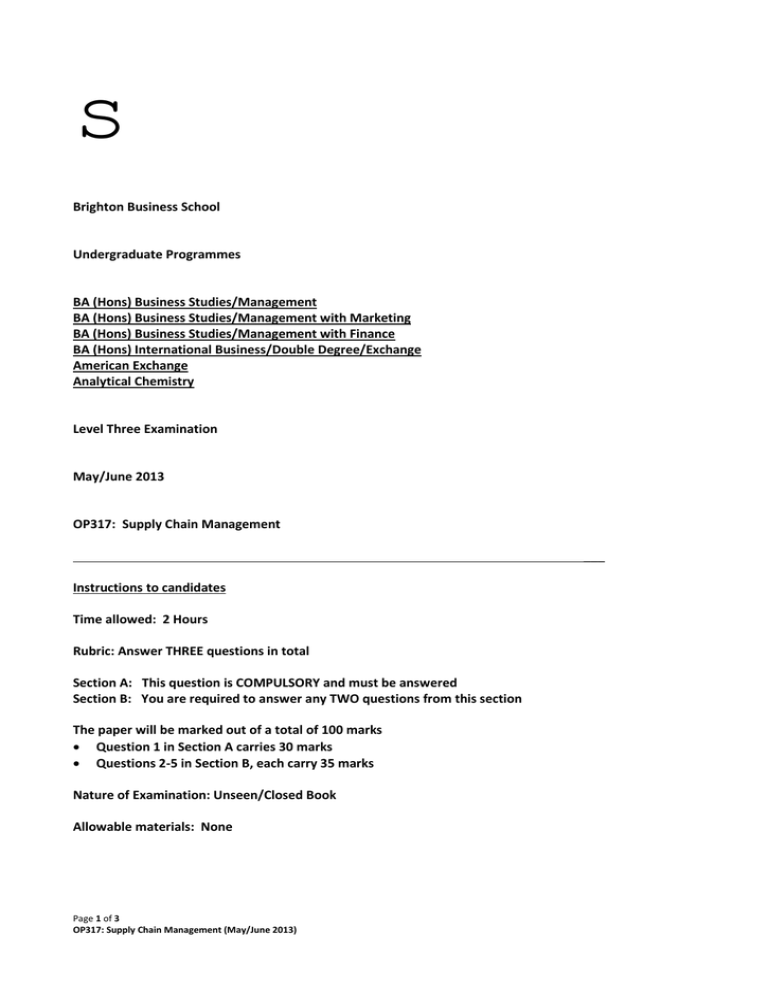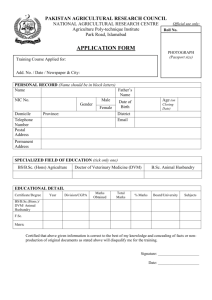OP317
advertisement

s Brighton Business School Undergraduate Programmes BA (Hons) Business Studies/Management BA (Hons) Business Studies/Management with Marketing BA (Hons) Business Studies/Management with Finance BA (Hons) International Business/Double Degree/Exchange American Exchange Analytical Chemistry Level Three Examination May/June 2013 OP317: Supply Chain Management ___ Instructions to candidates Time allowed: 2 Hours Rubric: Answer THREE questions in total Section A: This question is COMPULSORY and must be answered Section B: You are required to answer any TWO questions from this section The paper will be marked out of a total of 100 marks Question 1 in Section A carries 30 marks Questions 2-5 in Section B, each carry 35 marks Nature of Examination: Unseen/Closed Book Allowable materials: None Page 1 of 3 OP317: Supply Chain Management (May/June 2013) Section A: This question is COMPULSORY and must be answered Question 1 a) According to Chopra & Meindl (2010): “Effective supply chain management involves the management of supply chain assets, and of product, information and fund flows to maximise total supply chain profitability.” With this quote in mind, explain how firms strive to achieve integrated supply chain management in practice. You should illustrate your answer with a diagram and an example of a real supply chain, drawn from your own experience, reading or study. (15 marks) b) Some would argue that reverse logistics management and systems are relatively undeveloped in many companies. Using an example, discuss THREE issues that managers often face when planning and controlling reverse operations. (15 marks) Section B: You are required to answer any TWO questions from this section Question 2 a) Why should an organisation take a ‘total supply network’ perspective, when planning and designing its supply operations? Discuss THREE strategic design decisions that firms need to take when planning the overall configuration of their supply networks. (21 marks) b) Some companies, such as The Ford Motor Company, have many production sites around the world, whereas others, such as Dell Computers, have relatively few production facilities. Explain why different organisations choose to adopt different supply network configurations? (14 marks) Question 3 a) Martin Christopher (2011) argues that to be competitive in today’s volatile markets supply chains need to become more “agile”. What are the primary goals and distinguishing characteristics of a truly agile supply chain? Support your answer with TWO examples from your reading or own experience. (21 marks) b) In practice, it is often not possible to create an agile supply chain from end to end. Critically examine how some organisations have attempted to combine both agile and lean approaches in their supply chain operations, to achieve a hybrid solution. (14 marks) Page 2 of 3 OP317: Supply Chain Management (May/June 2013) Question 4 a) The ‘Beer Game’ was developed by the Massachusetts Institute of Technology (MIT) to highlight some of the problems found in traditional supply chains. Drawing on your experience of playing the game, and on your study of supply chain dynamics, explain the nature of these problems. Support your answer with one or more diagrams, illustrating the impact of these problems on supply chain performance. (21 marks) b) Explain how the adverse effects of the supply chain problems highlighted by MIT’s ‘Beer Game’ may be minimised, in practice. You may wish to draw on McCullen & Towill’s paper in Supply Chain Management (2002), or on other published work, to support your answer. (14 marks) Question 5 The example below illustrates the potential scale of financial risk, to an established and successful business, of disruption in the supply chain: In 2002 Land Rover’s sole supplier of chassis for its ‘Discovery’ 4x4 vehicle went into liquidation and the company estimated that it could take up to six months to bring an alternative source of supply on-stream. Therefore, to enable production to continue, Land Rover had no alternative but to finance the failed supplier from its own resources. a) Identify THREE major sources of vulnerability within modern, globalised supply chains. Then, suggest how these risks may be monitored, and how supply chain resilience may therefore be improved. (21 marks) b) The term ‘Partnership’ is used to describe the way some firms interact with each other in a supply chain. It represents one of several modes of interaction on a continuum of buyer-supplier relationships. Use an example, from your own experience or study, to critique the main elements of the partnership approach. (14 marks) Page 3 of 3 OP317: Supply Chain Management (May/June 2013)






